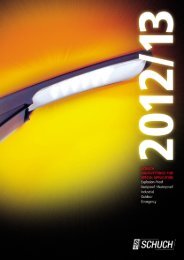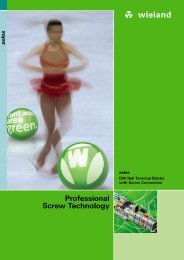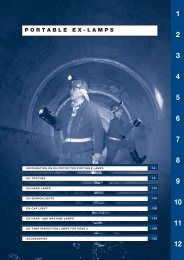- Page 1 and 2:
© Siemens AG 2011 DELTA Switches a
- Page 3 and 4:
DELTA Switches and Socket Outlets C
- Page 5 and 6:
© Siemens AG 2011 Answers for infr
- Page 7 and 8:
© Siemens AG 2011 Consistent, safe
- Page 9 and 10:
© Siemens AG 2011 More new version
- Page 11 and 12:
© Siemens AG 2011 Our added extra
- Page 13 and 14:
© Siemens AG 2011 DELTA miro Artis
- Page 15 and 16:
© Siemens AG 2011 DELTA natur DELT
- Page 17 and 18:
© Siemens AG 2011 DELTA profil Tit
- Page 19 and 20:
© Siemens AG 2011 I2_13487 7 Unifo
- Page 21 and 22:
© Siemens AG 2011 7 Put an end to
- Page 23 and 24:
© Siemens AG 2011 7 Lighting eleme
- Page 25 and 26:
© Siemens AG 2011 Degree of protec
- Page 27 and 28:
© Siemens AG 2011 DELTA shutter/bl
- Page 29 and 30:
© Siemens AG 2011 DELTA motion det
- Page 31 and 32:
© Siemens AG 2011 DELTA room tempe
- Page 33 and 34:
© Siemens AG 2011 DELTA miro Artis
- Page 35 and 36:
© Siemens AG 2011 DELTA reflex smo
- Page 37 and 38:
© Siemens AG 2011 Software at your
- Page 39 and 40:
i-system © Siemens AG 2011 1 1 1/2
- Page 41 and 42:
© Siemens AG 2011 i-system 1 Intro
- Page 43 and 44:
© Siemens AG 2011 i-system 1 Combi
- Page 45 and 46:
© Siemens AG 2011 i-system 1 Switc
- Page 47 and 48:
© Siemens AG 2011 i-system 1 Switc
- Page 49 and 50:
© Siemens AG 2011 i-system 1 Switc
- Page 51 and 52:
© Siemens AG 2011 i-system 1 Socke
- Page 53 and 54:
© Siemens AG 2011 i-system 1 Socke
- Page 55 and 56:
© Siemens AG 2011 i-system 1 Socke
- Page 57 and 58:
© Siemens AG 2011 i-system 1 Socke
- Page 59 and 60:
© Siemens AG 2011 i-system 1 Shutt
- Page 61 and 62:
© Siemens AG 2011 i-system 1 Shutt
- Page 63 and 64:
© Siemens AG 2011 i-system 1 Shutt
- Page 65 and 66:
© Siemens AG 2011 i-system 1 Light
- Page 67 and 68:
© Siemens AG 2011 i-system 1 Motio
- Page 69 and 70:
© Siemens AG 2011 i-system 1 Room
- Page 71 and 72:
© Siemens AG 2011 i-system 1 GAMMA
- Page 73 and 74:
© Siemens AG 2011 i-system 1 GAMMA
- Page 75 and 76:
© Siemens AG 2011 i-system 1 Commu
- Page 77 and 78:
© Siemens AG 2011 i-system 1 Equip
- Page 79 and 80:
© Siemens AG 2011 i-system 1 Add-o
- Page 81 and 82:
© Siemens AG 2011 i-system 1 Acces
- Page 83 and 84:
© Siemens AG 2011 i-system 1 Acces
- Page 85 and 86:
2 2 DELTA line © Siemens AG 2011 2
- Page 87 and 88:
© Siemens AG 2011 Modular componen
- Page 89 and 90:
© Siemens AG 2011 DELTA line Frame
- Page 91 and 92:
© Siemens AG 2011 DELTA line Socke
- Page 93 and 94:
© Siemens AG 2011 DELTA line Acces
- Page 95 and 96:
© Siemens AG 2011 DELTA vita Produ
- Page 97 and 98:
© Siemens AG 2011 DELTA vita Produ
- Page 99 and 100:
© Siemens AG 2011 DELTA vita Produ
- Page 101 and 102:
© Siemens AG 2011 DELTA vita Produ
- Page 103 and 104:
© Siemens AG 2011 DELTA miro 4 4/2
- Page 105 and 106:
© Siemens AG 2011 DELTA miro Intro
- Page 107 and 108:
© Siemens AG 2011 DELTA miro Intro
- Page 109 and 110:
© Siemens AG 2011 DELTA miro Frame
- Page 111 and 112:
© Siemens AG 2011 DELTA miro Compl
- Page 113 and 114:
© Siemens AG 2011 DELTA profil 5 5
- Page 115 and 116:
© Siemens AG 2011 DELTA profil Int
- Page 117 and 118:
© Siemens AG 2011 DELTA profil Int
- Page 119 and 120:
© Siemens AG 2011 DELTA profil Fra
- Page 121 and 122:
© Siemens AG 2011 DELTA profil Swi
- Page 123 and 124:
© Siemens AG 2011 DELTA profil Swi
- Page 125 and 126:
© Siemens AG 2011 DELTA profil Soc
- Page 127 and 128:
© Siemens AG 2011 DELTA profil 5UB
- Page 129 and 130:
© Siemens AG 2011 DELTA profil Int
- Page 131 and 132:
© Siemens AG 2011 DELTA profil Shu
- Page 133 and 134:
© Siemens AG 2011 DELTA profil Shu
- Page 135 and 136:
© Siemens AG 2011 DELTA profil Lig
- Page 137 and 138:
© Siemens AG 2011 DELTA profil Mot
- Page 139 and 140:
© Siemens AG 2011 DELTA profil Mot
- Page 141 and 142:
© Siemens AG 2011 DELTA profil GAM
- Page 143 and 144:
© Siemens AG 2011 DELTA profil GAM
- Page 145 and 146:
© Siemens AG 2011 DELTA profil GAM
- Page 147 and 148:
© Siemens AG 2011 DELTA profil Com
- Page 149 and 150:
© Siemens AG 2011 DELTA profil TV/
- Page 151 and 152:
© Siemens AG 2011 DELTA profil Add
- Page 153 and 154:
© Siemens AG 2011 DELTA profil Acc
- Page 155 and 156:
© Siemens AG 2011 DELTA style 6 6/
- Page 157 and 158:
© Siemens AG 2011 DELTA style Intr
- Page 159 and 160:
© Siemens AG 2011 DELTA style Fram
- Page 161 and 162:
© Siemens AG 2011 DELTA style 5TG7
- Page 163 and 164:
© Siemens AG 2011 DELTA style 5TG7
- Page 165 and 166:
© Siemens AG 2011 DELTA style Sock
- Page 167 and 168:
© Siemens AG 2011 DELTA style 5UB1
- Page 169 and 170:
© Siemens AG 2011 DELTA style Inte
- Page 171 and 172:
© Siemens AG 2011 DELTA style Shut
- Page 173 and 174:
© Siemens AG 2011 DELTA style Ligh
- Page 175 and 176:
© Siemens AG 2011 DELTA style Moti
- Page 177 and 178:
© Siemens AG 2011 DELTA style Room
- Page 179 and 180:
© Siemens AG 2011 DELTA style GAMM
- Page 181 and 182:
© Siemens AG 2011 DELTA style GAMM
- Page 183 and 184:
© Siemens AG 2011 DELTA style Comm
- Page 185 and 186:
© Siemens AG 2011 DELTA style Comm
- Page 187 and 188:
© Siemens AG 2011 DELTA style Modu
- Page 189 and 190:
© Siemens AG 2011 DELTA style Add-
- Page 191 and 192:
© Siemens AG 2011 DELTA style Acce
- Page 193 and 194:
© Siemens AG 2011 DELTA natur 7 7/
- Page 195 and 196:
© Siemens AG 2011 DELTA natur Intr
- Page 197 and 198:
© Siemens AG 2011 DELTA natur Fram
- Page 199 and 200:
© Siemens AG 2011 DELTA natur Swit
- Page 201 and 202:
© Siemens AG 2011 DELTA natur Shut
- Page 203 and 204:
© Siemens AG 2011 DELTA natur Comm
- Page 205 and 206:
© Siemens AG 2011 DELTA natur Add-
- Page 207 and 208:
© Siemens AG 2011 m-system 8 8/2 I
- Page 209 and 210:
© Siemens AG 2011 m-system Introdu
- Page 211 and 212:
© Siemens AG 2011 m-system Module
- Page 213 and 214:
© Siemens AG 2011 m-system Other m
- Page 215 and 216:
© Siemens AG 2011 Surface-Mounting
- Page 217 and 218:
© Siemens AG 2011 Surface-Mounting
- Page 219 and 220:
© Siemens AG 2011 Surface-Mounting
- Page 221 and 222:
© Siemens AG 2011 Surface-Mounting
- Page 223 and 224:
© Siemens AG 2011 Surface-Mounting
- Page 225 and 226:
© Siemens AG 2011 Surface-Mounting
- Page 227 and 228:
© Siemens AG 2011 Surface-Mounting
- Page 229 and 230:
© Siemens AG 2011 Surface-Mounting
- Page 231 and 232:
© Siemens AG 2011 Surface-Mounting
- Page 233 and 234:
© Siemens AG 2011 Surface-Mounting
- Page 235 and 236:
© Siemens AG 2011 Surface-Mounting
- Page 237 and 238:
© Siemens AG 2011 Surface-Mounting
- Page 239 and 240:
© Siemens AG 2011 Surface-Mounting
- Page 241 and 242:
© Siemens AG 2011 Switching/Pushbu
- Page 243 and 244:
© Siemens AG 2011 Switching/Pushbu
- Page 245 and 246:
© Siemens AG 2011 Switching/Pushbu
- Page 247 and 248:
© Siemens AG 2011 Switching/Pushbu
- Page 249 and 250:
© Siemens AG 2011 Switching/Pushbu
- Page 251 and 252:
© Siemens AG 2011 Switching/Pushbu
- Page 253 and 254:
© Siemens AG 2011 Switching/Pushbu
- Page 255 and 256:
© Siemens AG 2011 Switching/Pushbu
- Page 257 and 258:
© Siemens AG 2011 Switching/Pushbu
- Page 259 and 260:
© Siemens AG 2011 Switching/Pushbu
- Page 261 and 262:
© Siemens AG 2011 Motion Detectors
- Page 263 and 264:
© Siemens AG 2011 Motion Detectors
- Page 265 and 266:
© Siemens AG 2011 Automatic Lighti
- Page 267 and 268:
© Siemens AG 2011 Automatic Lighti
- Page 269 and 270:
© Siemens AG 2011 Shutter/Blind Co
- Page 271 and 272:
© Siemens AG 2011 Shutter/Blind Co
- Page 273 and 274:
© Siemens AG 2011 Shutter/Blind Co
- Page 275 and 276:
© Siemens AG 2011 Shutter/Blind Co
- Page 277 and 278:
© Siemens AG 2011 Shutter/Blind Co
- Page 279 and 280: © Siemens AG 2011 Room Temperature
- Page 281 and 282: © Siemens AG 2011 Room Temperature
- Page 283 and 284: © Siemens AG 2011 Data and Communi
- Page 285 and 286: © Siemens AG 2011 Data and Communi
- Page 287 and 288: © Siemens AG 2011 Data and Communi
- Page 289 and 290: © Siemens AG 2011 Data and Communi
- Page 291 and 292: © Siemens AG 2011 Data and Communi
- Page 293 and 294: © Siemens AG 2011 Remote Control S
- Page 295 and 296: © Siemens AG 2011 Remote Control S
- Page 297 and 298: © Siemens AG 2011 Remote Control S
- Page 299 and 300: © Siemens AG 2011 Remote Control S
- Page 301 and 302: © Siemens AG 2011 Remote Control S
- Page 303 and 304: © Siemens AG 2011 Remote Control S
- Page 305 and 306: © Siemens AG 2011 Remote Control S
- Page 307 and 308: © Siemens AG 2011 Smoke Detectors
- Page 309 and 310: © Siemens AG 2011 Smoke Detectors
- Page 311 and 312: © Siemens AG 2011 GAMMA Bus Coupli
- Page 313 and 314: © Siemens AG 2011 GAMMA Bus Coupli
- Page 315 and 316: © Siemens AG 2011 Technical Inform
- Page 317 and 318: © Siemens AG 2011 Technical Inform
- Page 319 and 320: © Siemens AG 2011 Technical Inform
- Page 321 and 322: © Siemens AG 2011 Technical Inform
- Page 323 and 324: © Siemens AG 2011 Technical Inform
- Page 325 and 326: © Siemens AG 2011 Technical Inform
- Page 327 and 328: - © Siemens AG 2011 Technical In
- Page 329: © Siemens AG 2011 Technical Inform
- Page 333 and 334: © Siemens AG 2011 Technical Inform
- Page 335 and 336: © Siemens AG 2011 Technical Inform
- Page 337 and 338: © Siemens AG 2011 Technical Inform
- Page 339 and 340: © Siemens AG 2011 Technical Inform
- Page 341 and 342: © Siemens AG 2011 Technical Inform
- Page 343 and 344: © Siemens AG 2011 Technical Inform
- Page 345 and 346: © Siemens AG 2011 Technical Inform
- Page 347 and 348: © Siemens AG 2011 Technical Inform
- Page 349 and 350: © Siemens AG 2011 Technical Inform
- Page 351 and 352: © Siemens AG 2011 Technical Inform
- Page 353 and 354: © Siemens AG 2011 Technical Inform
- Page 355 and 356: © Siemens AG 2011 Technical Inform
- Page 357 and 358: © Siemens AG 2011 Technical Inform
- Page 359 and 360: © Siemens AG 2011 Technical Inform
- Page 361 and 362: © Siemens AG 2011 Technical Inform
- Page 363 and 364: © Siemens AG 2011 Technical Inform
- Page 365 and 366: © Siemens AG 2011 Technical Inform
- Page 367 and 368: © Siemens AG 2011 Technical Inform
- Page 369 and 370: E © Siemens AG 2011 Technical Info
- Page 371 and 372: © Siemens AG 2011 Technical Inform
- Page 373 and 374: © Siemens AG 2011 Technical Inform
- Page 375 and 376: " " # # © Siemens AG 2011 Technica
- Page 377 and 378: © Siemens AG 2011 Technical Inform
- Page 379 and 380: = > - 9 . © Siemens AG 2011 Techni
- Page 381 and 382:
© Siemens AG 2011 Technical Inform
- Page 383 and 384:
© Siemens AG 2011 Technical Inform
- Page 385 and 386:
© Siemens AG 2011 Appendix 20 20/2
- Page 387 and 388:
© Siemens AG 2011 Appendix Orderin
- Page 389 and 390:
© Siemens AG 2011 Appendix Siemens
- Page 391 and 392:
© Siemens AG 2011 Appendix Service
- Page 393 and 394:
© Siemens AG 2011 Appendix Compreh
- Page 395 and 396:
© Siemens AG 2011 Appendix Subject
- Page 397 and 398:
© Siemens AG 2011 Appendix Subject
- Page 399 and 400:
© Siemens AG 2011 Appendix Subject
- Page 401 and 402:
© Siemens AG 2011 Appendix Order N
- Page 403 and 404:
© Siemens AG 2011 Appendix Order N
- Page 405 and 406:
© Siemens AG 2011 Appendix Order N
- Page 407 and 408:
© Siemens AG 2011 Appendix Order N
- Page 409 and 410:
© Siemens AG 2011 Appendix Order N
- Page 411 and 412:
© Siemens AG 2011 Appendix Order N
- Page 413 and 414:
© Siemens AG 2011 Appendix Terms a
- Page 415 and 416:
© Siemens AG 2011 Catalogs Industr
















